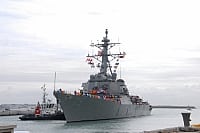
The Navy is confident it can transition to the next version of the Arleigh Burke-class (DDG-51) destroyers in the 2016 timeframe now that the service has settled on a new radar and can begin detailed design, the program manager for the ship class recently said. The Navy plans to begin construction on the flight III DDG-51s in 2016. The key feature on the upgraded versions will be the new Air Missile Defense Radar, a new and more powerful radar for…













